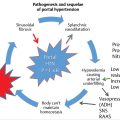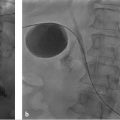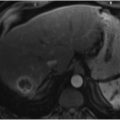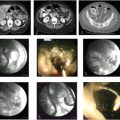16 Management of Locally Advanced Hepatocellular Carcinoma
Olaguoke (Goke) Akinwande and Hyun S. Kim
16.1 Introduction
Hepatocellular carcinoma (HCC) is an aggressive primary liver tumor that typically occurs in the background of chronic liver disease or cirrhosis. The prognosis is related to the patient′s treatment options and hepatic reserve. Patients with small volume disease (solitary mass < 5 cm or few masses < 3 cm) with good performance status and preserved hepatic function have more treatment options that include resection, transplantation, and ablation with curative intent. These patients generally have good prognosis. On the other hand, patients with advanced HCC have fewer treatment options. These patients are usually not surgical candidates and some do not qualify for locoregional therapies (LRT) such as chemoembolization and radioembolization. As a result, their prognosis is poor, sometimes dismal.
Advanced HCC comprises those patients with any one or combination of the following characteristics: Eastern Cooperative Oncology Group (ECOG) performance status > 0, presence of vascular invasion, and extrahepatic disease. These patients typically fall in the Barcelona Clinic Liver Cancer (BCLC) stage C category. The BCLC staging system is widely utilized and endorsed by the American Association for the Study of Liver Diseases (AASLD). This staging system, which pairs each stage of the disease with a recommended treatment based on best available evidence, recommends that patients with advanced HCC be treated with systemic therapy (i.e., sorafenib). However, new studies have provided insight into the value of other treatment options such as LRT and radiation therapy (RT) in this patient population. This chapter will give insight into the management approach of treating locally advanced HCC.
16.2 Establishment of Locally Advanced Hepatocellular Carcinoma
As mentioned earlier, advanced HCC includes those with any one or combination of ECOG performance status > 0, macrovascular invasion, and extrahepatic disease. The background liver function can are variable, including those with Child–Pugh (CP) status A and B. CP C patients are in the terminal stage of HCC and may not tolerate any therapy more aggressive than best supportive care. The ECOG score, which highly correlates with the patient′s prognosis, is established clinically by taking into account the patient′s symptomatology and level of activity. Vascular invasion and the presence of extrahepatic disease require imaging evaluation. The imaging characteristics of typical HCC on contrast computed tomography (CT) or magnetic resonance imaging (MRI) show a hypervascular mass on the arterial phase with enhancement washout on the venous phase of imaging. On contrast-enhanced CT, nonopacification of the portal vein in the portal-venous phase indicates vascular invasion. This is a poor prognostic sign. The corresponding finding on T1 contrast-enhanced MRI is lack of contrast filling in the portal vein. Increased intravascular T2 signal on MRI is also indicative of vascular invasion. The most common sites of metastatic disease from HCC are the lung, abdominal lymph nodes, and bone. 1
16.2.1 Staging and Treatment Approach
Using tumor stage to determine the appropriate treatment for HCC is difficult because every case is unique, differing in disease state and geographic variability. Another challenge in treating HCC is that differences in patient demographic and background liver disease etiology may affect the efficacy of therapy. For instance, Asian populations tend to involve younger patients with chronic hepatitis B or C and well-compensated cirrhosis. In the western world, patients with HCC are older with alcoholic cirrhosis or nonalcoholic fatty liver disease. These demographic differences can significantly impact the efficacy of treatment; therefore, studies that apply to a specific population cannot be extrapolated to serve another. Constant development of new treatments and new indications for older treatments also affect the ability to formalize rigid criteria regarding HCC treatment.
Nonetheless, the treatment of HCC is still in large part determined by the stage of disease. The stage of disease provides a starting point in deciding how aggressive the treatment approach should be. Many staging systems currently exist, but those that are pathologically based (i.e., Liver Cancer Study Group of Japan [LCSGJ], Chinese University Prognostic Index [CUPI]) are not the most helpful in determining the choice of therapy in advanced stage disease. This is because the diagnosis of HCC can be established in most cases without a pathological specimen. Also, often the goal of this treatment is palliation and rarely curative (for unresectable HCC); therefore, obtaining a pathologic specimen is redundant. Clinical staging systems are more helpful because the diagnosis of HCC is largely imaged based and imaging is assessable and convenient.
Most of the available clinical staging systems are more useful in directing surgical and transplantation decisions (Okuda, Cancer of the Liver Italian Program [CLIP], etc.). The BCLC staging system is of particular interest to oncologists and interventional radiologists because it has been validated as a prognosticator and each stage is paired with a particular treatment based on the best available evidence. 2 This staging system is based on tumor size, number of lesions, vascular invasion, hepatic function (Child–Pugh score), extrahepatic disease, and performance status. In brief, curative surgery (resection/transplant) is recommended for early-stage disease (BCLC A), transarterial chemoembolization (TACE) for intermediate-stage disease (BCLC B), sorafenib for advanced-stage disease (BCLC C), and best supportive care for terminal stage disease (BCLC D; ▶ Table 16.1).
While quite comprehensive, some argue that the BCLC staging system may be too rigid. In other words, it may not reflect novel advances in knowledge, aggressive surgical strategies, new medications, or new technologies. For example, it does not advocate transarterial therapy for patients with advanced HCC who may potentially benefit from it. Further, there are intermediate-stage patients that may benefit from a more aggressive surgical approach. 3 The Hong Kong Liver Cancer staging system is less rigid and may outperform BCLC staging in prognostic significance, but it needs to be validated in non-Asian populations. 4 The Americas Hepato-Pancreato-Biliary Association consensus statement advocated the need to utilize different systems in different patients. They recommended using the TNM system to predict prognosis after surgery (resection or transplant) and the BCLC criteria for nonsurgical HCC patients. To that end, interventional oncologists may find the BCLC criteria the most useful as they plan treatment strategies for patients with advanced HCC. 3
16.3 Response Assessment
In patients with elevated alpha-fetoprotein (AFP) levels, AFP trends can screen for disease progression after treatment. When the AFP level decreases by 20% from baseline after treatment, the median survival has been found to be greater than nonresponders. Any decrease in AFP should be verified with imaging as the AFP trend should mirror the imaging findings. 5 The limitation of AFP is that a nontrivial fraction of patients with HCC may not have significantly elevated AFP levels to allow biochemical response assessment.
A more effective and practical way of assessing response is using cross-sectional imaging (i.e., CT, MRI). Imaging biomarkers can be used as a surrogate for survival. There are three commonly used imaging criteria used to assess solid liver tumors after treatment: Response Evaluation Criteria in Solid Tumors (RECIST), modified RECIST (mRECIST), and European Association for the Study of the Liver (EASL; ▶ Table 16.2).
The RECIST, which grades response based on variations in tumor size, was established to assess cytotoxic treatment effect on solid tumors. However, size-based criteria are not optimal in this patient population 6 , 7 because HCC behaves differently when treated with LRT or biologic agents (which are cytostatic not cytotoxic). Specifically, sometimes the post-treatment target lesion may remain stable in size or even increase in size compared to baseline. To circumvent these limitations, viability-based criteria were developed. The EASL and mRECIST were both developed to take advantage of the exuberant enhancement of HCC. Rather than evaluating treatment response using differences in size, changes in the amount or pattern of enhancement are prioritized. These enhancement (viability) based imaging criteria are superior to anatomic imaging biomarkers in evaluating patients with HCC treated with LRT. 8 , 9 , 10 , 11 The main difference between EASL and mRECIST is that the former is two-dimensional and the latter is unidimensional. With these imaging criteria, one can assign the following categories based on the strict guidelines: complete response (CR), partial response (PR), stable disease (SD), and progressive disease (PD). Each of these categories correlates with the prognosis of the patient after treatment.
16.4 Therapeutic Options for Advanced Hepatocellular Carcinoma
The decisions regarding the management of patients with advanced HCC must be performed in a multidisciplinary setting, as the treatment spans many specialties and expertise. According to the BCLC criteria, the management of advanced HCC is systemic therapy; however, there is growing evidence supporting the use of other modalities such as LRT. Therefore, treatment decisions should not be made in isolation. The treatment options for advanced HCC are discussed below.
16.4.1 Systemic Therapy
Cytotoxic chemotherapy has limited utility in the treatment of advanced HCC because HCC is a relatively chemorefractory tumor. On the other hand, molecular systemic therapy shows more promise in this setting because of HCC tumor biology. Fortunately, HCC tumors are very vascular tumors that markedly express vascular endothelial growth factors (VEGF) and the RAF/mitogenactivated protein kinase (MAPK)/extracellular signal–regulated kinase (ERK) pathway is important for HCC tumorigenesis. These elements provide useful targets for systemic treatment. Sorafenib, a biologic agent, has been proven to provide some efficacy as monotherapy in treating advanced HCC. Other biologic agents have been studied, but none so far has been proven in this patient population. Detailed description of these biologic agents is outside the scope of this chapter.
Sorafenib
The generally accepted standard of care for patients with advanced HCC is systemic administration of sorafenib. Sorafenib is currently the only molecularly targeted therapy approved by the U.S. Food and Drug Administration (FDA) for the treatment of HCC. Sorafenib is a multitargeted tyrosine kinase inhibitor (TKI) that acts by inhibiting the VEGF receptor pathway and Raf kinases (▶ Fig. 16.1).

Its effect mechanism induces autophagy, thereby leading to suppression of cancer cell growth. The pivotal trial that led to its widespread use was the Study of Heart and Renal Protection (SHARP) trial, which was a multicenter study comprising 602 patients. This European study randomized patients to sorafenib and placebo groups. The result of this trial was an overall survival (OS) that favored the treatment group (treatment group 10.7 months; control group 7.9 months; p < 0.001). 12 This study established sorafenib monotherapy as the treatment of choice for advanced HCC in a western population. However, most HCC cases are found in hepatitis B virus (HBV)/hepatitis C virus (HCV) endemic areas (Asia-Pacific, Africa); therefore, the etiology is very different from the Western HCC population. Therefore, the SHARP trial population did not address the HBV/HCV endemic populations. To address this problem, another phase III randomized control trial from the Asia-Pacific region was performed on 226 patients. OS was again noted to favor the treatment group (6.5 vs. 4.2 months; p = 0.014), thereby validating the SHARP trial in an HBV/HCV endemic population. Positive results in both trials demonstrate that sorafenib is effective regardless of the HCC sample population.
Treatment of advanced HCC patients should be limited to those with CP A and B cirrhosis. Patients with CP C cirrhosis have a short prognosis due to severe hepatic disease; therefore, they are unlikely to benefit from sorafenib. 13 Of note, there is a higher risk of serious adverse effects in CP B patients compared with CP A (60 vs. 33%). 14 Common side effects associated with sorafenib usage include hand–foot syndrome, diarrhea, alopecia, liver dysfunction, nausea, fatigue, and anorexia.
Sorafenib should be considered for any patient with advanced HCC. There are ongoing trials evaluating sorafenib-based combination therapies to enhance the efficacy of this treatment.
Stay updated, free articles. Join our Telegram channel

Full access? Get Clinical Tree








